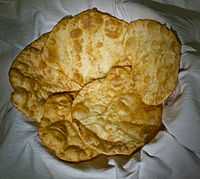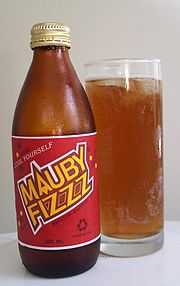Dominican Republic cuisine
Dominican Republic cuisine is predominantly made up of a combination of Spanish, indigenous Taíno, and African influences, the first and last occurring over the last five centuries. Dominican cuisine resembles that of other countries in Latin America, those of the nearby islands of Puerto Rico and Cuba, most of all, though the dish names differ sometimes.
Breakfast can consist of eggs or meat and mangú (mashed plantain). A heartier version uses deep-fried meat, such as Dominican salami. As in Spain, the largest, most important meal of the day is lunch. Its most typical form, nicknamed La Bandera ("The Flag"), consists of rice, red beans, meat (beef, chicken, pork, or fish), and salad.
Dishes and their origins
The Dominican Republic was formerly a Spanish colony. Many Spanish traits are still present in the island. Many traditional Spanish dishes have found a new home in the Dominican Republic, some with a twist. African and Taíno dishes still hold strong, some of them unchanged.
All or nearly all food groups are accommodated in typical Dominican cuisine, as it incorporates meat or seafood; grains, especially rice, corn (native to the island[1]), and wheat; vegetables, such as beans and other legumes, potatoes, yuca, or plantains, and salad; dairy products, especially milk and cheese; and fruits, such as oranges, bananas, and mangos. However, there is heaviest consumption of starches and meats, and least of dairy products and non-starchy vegetables.
Sofrito, a sautéed mix of local herbs and spices, is used in many dishes. Throughout the south-central coast bulgur, or whole wheat, is a main ingredient in quipes and tipili, two dishes brought by Levantine Middle Eastern immigrants. Other favorite foods and dishes include chicharrón, pastelitos or empanadas, batata, pasteles en hoja (ground roots pockets), chimichurris, plátanos maduros (ripe plantain), and tostones.
Taíno dishes
- Casabe – bread made out of yuca
- Guanimos - Guanimo, are tamales or hallaca. A dish that can be traced back to Mesoamerica Aztec and Mayan culture. Guanimos are prepared exactly to tamales and hallaca. Cornmeal or cornflour made into a masa then stuffed and wrapped with banana leaf or cornhusk.
Spanish dishes
- Arroz con leche or arroz con dulce – rice pudding.
- Crème caramel - known as flan.
African dishes

- Mangú – mashed, boiled plantain. Originated in west Africa and is known as fufu in Africa, Cuba and Puerto Rico. This is a typical Dominican breakfast but can also be served at lunch and dinner. Mangú is servers with fried cheese, Dominican salami, eggs and topped with onions cooked in vinegar.
Other dishes

- Arroz con almendras y pasas - Rice with raisins and almonds. A very popular Arab dish brought over by Lebanese it is usually eaten around Christmas.
- Asopao - Rice soup from Puerto Rico that can be traced back to the island in the early 1800s. Asopao can be made with chicken, shrimp or sea food in general.
- Yanikeke – Jonnycakes a dish brought by sugar cane workers from the Lesser Antilles over a century ago.
- Kipes or Quipes (deep fried bulgur roll) - A version of the Middle Eastern kibbeh, brought by a wave of Middle Eastern immigrants that arrived in the Dominican Republic at the end of the 19th century.
- Mofongo – a popular fried plantain dish from Puerto Rico.[2] It is made from fried green plantains or fried yuca, seasoned with garlic, olive oil, and pork cracklings, then mashed with a little broth. Mofongo is usually served with a chicken broth soup.
- Pasteles en hojas – Originated in the Puerto Rico tubers and/or plantains are grated and the paste is formed into a rectangular purse shape, stuffed with meat. They are then tightly wrapped in a banana leaf and boiled. Pasteles are usually served on Christmas and have become a staple in Dominican cuisine.
- Tostones – fried green plantain slices served flattened and salted.
Dominican dishes
- Chambre - legumes, rice and meat stew. It has African origins in the poor rural parts of the Dominican Republic.
- Mondongo – beef tripe soup. Most likely made by African slaves.
- Chen-chen - A cracked corn pilaf dish originating in San Juan De La Maguana with African influences.
- Arañitas – yuca fritters.
- Moro de guandules con coco – rice, peas, and coconut milk dish. This dish originated in Samaná.
- Sancocho – very hearty stew with a mixture of meats including chicken, pork, shrimp or fish, and several tubers and vegetables, like cassava, corn, potatoes, yautía, and yam. The sancocho de siete carnes (seven-meat sancocho) and sancocho de habichuelas (bean sancocho) are unique to the Dominican Republic.
- Niño envuelto – rice cake wrapped in cabbage leaf. A dish influenced by Lebanese immigrants.
- Chicharrón de pollo – fried boneless chicken.
- Carne mechada - Braised beef roll. Not to be confused to the Venezuelan dish of shredded meat also known as carne mechada.
- Chapea - Red or white beans stew with mashed squash, longaniza (sausage), and ripe plantains.
- Habichuelas blancas con longaniza - White bean stew with longaniza.
- arroz con maiz - Rice with corn. A popular staple of the Dominican cuisine. It combines the sweet flavor of corn with the salty flavor of rice and other ingredients.
- Locrios - A classic style of mixing rice with other kind of meat. There are many variations of this dish, some being unique to the Dominican Republic. The famous dish arroz con pollo, is called locrio de pollo in the Dominican Republic.
- Chimichurris - Hamburgers topped with cabbage slaw.
- Pan de coco - Coconut bread.
- Camarones con coco y gengibre - Shrimp with coconut and ginger. This dish is prepared with Dominican seasoning as a base and with the addition of coconut milk and ginger.
- Mazamorra - Mashed Squash topped with onions.
- Buche e perico - Literally parrot's cheek. A hearty corn stew.
- Bollitos de yuca - cassava fritters balls stuffed with cheese.
- Pico y pala - Pick and shovel. Chicken feet and neck is associated with the popular dining rooms and cafeterias, very common in low income neighborhoods. Usually cooked with onions, cilantro, culantro, oregano, and sugar.
- Bollos de harina de maiz
- Guisados - There are many stew recipes in Dominican cooking many with same or similar seasoning. Stews such as eggplant, okra, heart of palm, beans, meat, fish, shellfish, even cow tongue and chicken feet can be stewed. Because most of the country is scarce on food Dominicans tend to guisado what they can settle on.
- Bolitas o bollitos de platano maduro y queso - ripe plantain balls filled with cheese
- Lengua picante - spicy cow tongue
- Crema de cepa de apio
- Wasakaka - Mojo sauce know as waskaka in The Dominican Republic. It refers to roasted chicken marinated in sour orange and garlic with boiled cassava on the side. A play of a classic Cuban dish roasted pork in mojo with fried or steamed cassava.
- Queso Frito - White cheese fried in a pan.
Desserts
- Arepa – Cornmeal and coconut cake. Dominican arepa is different from that of the Venezuelan and Colombian arepa.
- Dulce de leche – A recipe from Argentina that's very popular in Latin America. Dominican dulce de leche is thicker then Argentinean and always has cinnamon.
- Habichuelas con dulce – sweet creamed beans dessert. Made with coconut milk, sweet potato chunks, etc.
- Bizcocho Dominicano – Dominican cake.
- Mala Rabia -Sweet plantains, guava, and sweet potato cooked in simple syrup and cinnamon.
- Jalao - Chewy balls of "pulled" coconut and molasses.
- Conconete - Coconut macaroons with ginger and cinnamon.
- Majarete - Corn pudding made with fresh corn, cornstarch, milk, vanilla and cinnamon. Some Dominicans add coconut milk and nutmeg.
- Chaca - Corn pudding made with corn kernels, milk, cinnamon, clove and sometimes cooked rice.
- Gofio - A sweet cornmeal powder from the Canary islands.
- Cancina
- Palitos de coco
- Quesillo de coco
- Dulce de leche cortada
- Dulce de coco tierno
- Jalea de batata - sweet potato pudding
- Dulce de leche con pina - Dulce de leche with pineapple
- Amibar de frutas
Beverages

- Morir Soñando - a popular orange juice, milk, and sugar drink
- Ponche - eggnog is very popular around Christmas time
- Mabí – juice made from colubrina bark or fruit, sometimes fermented, sometimes spiced
- Mama Juana - an alcoholic drink concocted by allowing rum, red wine, and honey to soak in a bottle with tree bark and herbs
- Pera Piña - A drink that originated in the Andes of Pure. This drink is usually made by boiling the skin of a pineapple with spices and corn cob or rice together. The drink is then frozen. It is called this way because of the pear taste it contains
- Jugo de avena - oatmeal juice
- Chocolate de mani - peanut based hot chocolate
- Cerveza - beer especially Presidente
- Chocolate de agua - chocolate with water rather than milk
- Batidas - tropical fruit smoothies
- Jugos Naturales - fresh, natural tropical fruit juices
- Punche de Malta - Malta mixed or blended with ice cubes and milk or condensed milk.
Geographical differences
What Dominicans tend to eat depends highly on where they live: whether near the sea or in the interior mountains. In either case, most Dominican meat dishes tend to involve pork, as pigs are farmed quite heavily on the island. Meat dishes tend to be very well cooked or even stewed in Dominican restaurants, a tradition stemming from the lesser availability of refrigeration on the island.
Seaside Dominican fishing villages will have great varieties of seafood, the most common being shrimp, marlin, mahi-mahi or dorado, and lobster. Most villagers more commonly dine on cheap, lesser-quality fish, usually stewed with la criolla, a type of rice. Premium seafood tends to be too expensive for the many locals, and is saved for the island's upper class and the tourist resorts.
Differences between Dominican cuisine and those of other parts of the West Indies include the milder spicing of the Dominican, which mainly uses onions, garlic, cilantro, cilantro ancho (culantro), ají cubanela (cubanelle pepper), and oregano. Dominican sofrito is known on the island as sazon.
References
- ↑ "Food Crops". U.S. Library of Congress. Retrieved 2011-02-10.
- ↑ Clara R. Gonzalez; , Ilana Benady, Jill Wyatt (2007). Traditional Dominican Cookery. Lulu.com. p. 56. ISBN 9945-04-501-6.
Further reading
- Castro, Marianela; Clavé, Montse; Alcántara, Luz María (1996). Cocina Dominicana: Volume 2 of Cocinas de allí, aquí. Icaria Editorial. ISBN 978-84-7426-277-3.
- Féliz-Camilo, Arturo (2012). Las recetas de Mamá Pura: Volume 1 El Fogoncito collection. CreateSpace. ISBN 978-1-4752-8083-8.
- Féliz-Camilo, Arturo (2013). Diccionario Culinario Dominicano. CreateSpace. ISBN 978-1-4840-1111-9.
External links
| ||||||||||||||||||||||||||||||||||
| ||||||||
